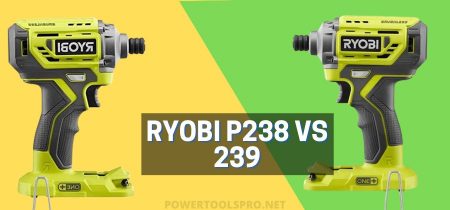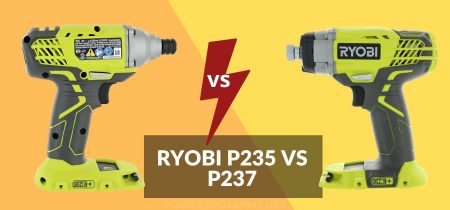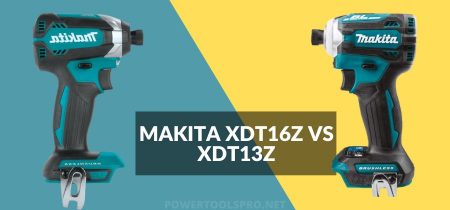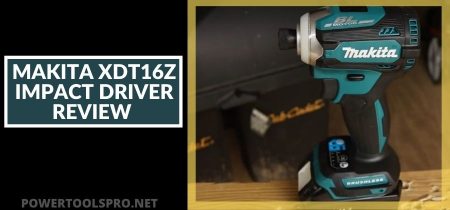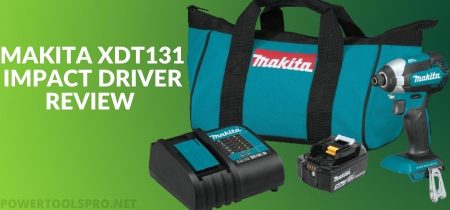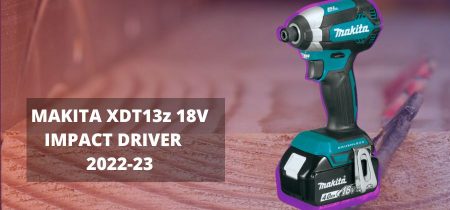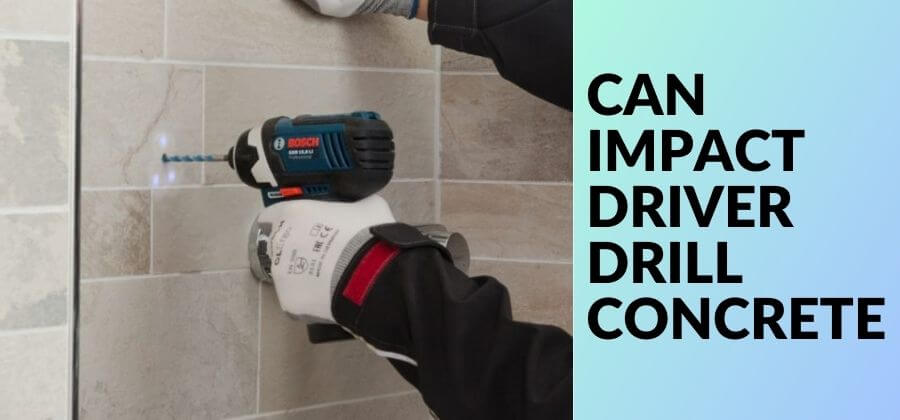
An impact driver is a tool that delivers a sudden, strong rational force which makes it an excellent tool for driving screws, nuts, and a basic level of drilling. But can impact driver drill concrete?
Well, an impact driver doesn’t come with variable speeds or settings to equip you with high-end accuracy. So, you can’t expect it to stay with you when you need precision while drilling the concrete. Moreover, you must limit the use of impact drivers to projects where you need wider holes in the concrete with greater accuracy.
When it comes to using an impact driver for drilling into concrete, the chosen drill bits can be real game-changers. Mainly impact driver concrete drill bits are a preferred version to use for easier and efficient holes through concrete. Make sure that they are compatible with concrete drilling, otherwise, you might end up with accidents or uneven concrete holes. If you know which drill bits are best to drill holes in concrete, then an impact driver can ease your job.
Hold in there, don’t rush into this process if you have a short time to do the trick as using an impact driver to drill concrete is quite a time-taking task. If you don’t know how to use an impact driver to drill concrete, how to fix drill bits, and associated issues with this technique, continue reading with me to get answers to many other questions.
How to Drill into Concrete using Impact Driver?
An impact driver is a cordless drill driver in which impacts are applied with a high level of torque. Due to its cordless nature, you can expect to use it even in tight corners or hard-to-access places but will the impact driver drill into concrete?
How to drill a 4-inch hole in concrete? Well, if you want to drill some holes in concrete and hold an impact driver, then you must know how to drill into the concrete using this tool. Keep in mind that this job can be a bit time-consuming and demands more effort.
Let’s discuss how to use an impact driver for this purpose.
- Firstly, you need to get a whole set of masonry bits that are specifically designed for impact hammers. You shouldn’t try drill bits that aren’t designed for impact hammers as they can be broken or shattered. If you want to make bigger holes, try to grab the compatible bits to do the trick.
- Then carefully mark the center of the hole to get an idea of where you should start drilling. Here, you can mark all the holes instantly or proceed separately for each hole.
- Now pick the smallest masonry bit to drill. You need to apply steady but gentle pressure to get an even hole. If you ever feel the drill resistance, simply reduce the pressure.
- When you get the hole of your bit’s size, stop drilling. Increase the size of the drill bit by one step and start drilling again. If your tool binds hard, insert a hardened nail into the hole and hit it hard with a hammer to break the concrete from inside.
- Once you get the desired diameter, continue to drill until you achieve the marked depth and try to keep the impact driver as steady as possible to prevent the drill bit from breaking.
- Make sure to repeat the nail and hammer periodically to continue the drilling and to break up the concrete.
How do you Put a Drill Bit in an Impact Driver?
In actuality, the Impact drivers can only be used with 1/4″ hex shank accessories, but keep in mind that all hex shank drill bits might not be compatible. Stunningly, they’re specifically carved for drilling concrete with an impact driver.
The good thing is that masonry bits for impact drivers are shorter than conventional drill bits. Moreover, they are carved much more durable to bear the stress of repeated hammer blows.
Furthermore, some are specifically designed to drill through rebar in concrete. Once you get the right drill bit, you must know how to effectively put it in an impact driver. Let’s discuss the steps to do the trick.
Step#1: Loosen the Chuck
The chuck is a piece on the end of the impact driver that can be loosened and tightened to hold the bit. To loosen it, grab the chuck with one hand and the handle of the impact driver with the other hand. Now twist the chunk in an anti-clockwise direction to do the trick. In this way, jaws will be open to clamp the drill bit.
Step#2: Set in the Bit
Here, you need to hold the bit with your thumb and index finger in such a way that the smooth part of the bit must be facing the jaws of the chuck. Then insert the bit in the chuck and instantly pull it back about a centimeter towards you. Don’t leave the bit as it isn’t secured now and can fall out.
Step#3: Tighten the Bit
You can tighten the bit by squeezing the trigger. All you need to do is to give a few short squeezes to trigger with one hand and keep the other hand on the bit to keep it in place. We recommend you tightly hold the bit while squeezing to ensure that the bit is installed exactly straight.
Step#4: Tighten the Chuck
If your impact driver allows a ratcheting mechanism, apply some extra pressure to the shank of the drill bit to click it at the place. Firmly twist the chuck in a clockwise motion to tightly hold the bit.
Can you Use an Impact Driver for Drilling?
The precise answer to this question is “YES”. You can use an impact driver for drilling but the most important thing is the right drill bit. They are designed to drive screws and fasten nuts and bolts, but they are multi-functional.
If you’re planning to drill a hole at 1/4 inches or under through brick or some concrete, then an impact driver can do the trick for you. But if you need a hole bigger than 1/4 inches through thick concrete, then you can’t use an impact driver for the task.
As impact drivers aren’t specifically designed for drilling, so they can’t grip accessories as tightly as drill chuck does. Rather they are compatible with only limited accessories, otherwise, they can cause serious damage to die to powerful impact mechanisms.
If you remain using an impact driver for the whole day’s tasks and now just need to drill a couple of holes, then just carry a few additional drill bits to accomplish your drilling task rather than carrying a dedicated heavier tool. Another major benefit of using an impact driver is that you can swap bits quite instantly to swiftly swap between applications.
Overall, impact drivers are powerful and compact tools that without adding much weight to your tool gear, can assist you in accomplishing a drilling task whenever needed.
Can an Impact Driver Drill into Brick?
The short answer to this question is “YES”, but some exceptions are there. Their hammering is entirely in a rotating sense, not front forward as we need for masonry or concrete.
When it comes to bricks, if you need to drill holes at 1/4 inches or under, you can use the impact driver to drill for you. But if you need bigger holes than 1/4 inches in diameter, an impact driver won’t do the job for you. Although impact drivers have an excellent amount of torque, they aren’t designed to be used as a hammer drill or regular drill.
Overall, you can use an impact driver to drill into bricks to get the limited-sized holes to meet your basic needs. Hold in there, try not to expect a granted accuracy from impact drivers while drilling into bricks, rather just use them in an hour of need or when you don’t have a dedicated tool to make your job done.
Hammer Drill vs Impact Driver
Most people assume that the hammer drill and impact driver are extensively similar in the way they operate, so they think that both tools work the same to drill holes in concrete. But the reality is different, a hammer drill and an impact driver are completely different in the way they deliver their “impact”. Let’s have a look at what obvious dissimilarities are there in both.
Hammer Drill
Grounded in fact, a hammer drill is designed to deliver the impact just like a hammer. In actuality, it comprises two jagged discs which are placed in a way to drive the drill bit back and forth in the concrete and as a result the hammer drill hammer the concrete and tends to pulverize it whilst spinning. Also, the weight range of hammer drills varies from 4 to 8 pounds, which is quite higher than the impact driver’s weight range.
Moreover, a hammer drill is a preferred tool for drilling into masonry and concrete. They made it possible by combining the rotational torque of the drill with the repeated percussion coming from behind and hence forcing the drill bit forward to do the trick. You can expect them to drill well even through tough concrete surfaces.
Impact Driver
On the other hand, the impact driver produces impact in a rational direction rather than back and forth in an axial direction as we discussed in the hammer drill. It is designed in a way that it engages and disengages whilst it’s spinning which delivers torque and hence it’s an optimal choice for installing bolts and screws.
During operation, their high rotational force allows them to drive screws without stripping or slipping. Even though they generate a high amount of torque and power, they are not excellent for drilling concrete. Overall, they are somewhat lighter and suit the best for woodwork.
PowerToolsPro Conclusion
On a clear note, the impact drivers are designed in a way to deliver impact in an axial direction. So, worldwide they are famous for their ability to drive screws, bolts, and nuts. Can an impact driver drill concrete? As we know that concrete is hard then we can expect to exert more force so you must have a strong, sharp, and accurate tool to drill through concrete.
As far as impact drivers are concerned, they aren’t ideal for drilling into concrete, but they can hold you back when you need smaller holes in bricks or concrete with less critical aspects. After reading the guide, you must have got the answer to all your questions related to concrete drilling with an impact driver. I hope this answers your question can an impact driver be used to drill concrete. Don’t rush, read well, before you perform.
